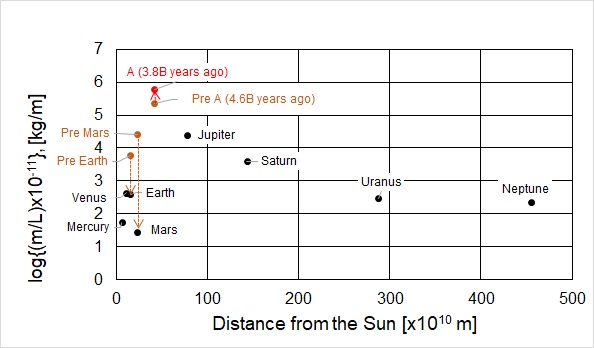6.3 A Model of a Giant Gas Planet (X) in an Asteroid Belt

Fig.17. Planets (A) and primitive Mars and the primitive Earth and current
planets.
Fig.17 shows planets in the solar system and a virtual planet (X) that
cause a deuterium nuclear fusion in the asteroid belts The gravitational
potential of the planets on the vertical axis of the logarithmic scale
against the distance from the Sun to the planet on the horizontal axis
of is shown in Fig.17. Here, as shown in brown points on Fig.17, it is
assumed that just before the Sun began fusion (4.6 billion years ago),
primitive Mars had grown to gas planets nearly same as Saturn and primitive
Earth had grown to as the same as Uranus.
After the Sun began the nuclear fusion 4.6 billion years ago, primitive
Mars and the primitive Earth have been heated by the radiation of light
and the solar wind from the Sun. The hydrogen gas on the primitive Mars
and that of the primitive Earth was lost and mass of primitive planets
was decreased as indicated by the black dot.
On the other hand, a virtual planet (X) located near frost line in
the asteroid belt had been grown to the planet with mass of five times of Jupiter just
before the Sun began fusion as indicate at a brown point. After the Sun began the nuclear fusion,
since the planet (X) had a much larger mass and stronger magnetic field than Jupiter, it captured a
large amount of debris from the Sun's core and also captured the hydrogen gas released
from primitive Mars and primitive Earth. Thus, big planet (X) had continued to grow more larger by capturing a
wide range of interstellar matter. It is the scenario that the planet reached
13 times the mass of Jupiter and caused the deuterium fusion 3.8 billion
years ago.
index -6.2-